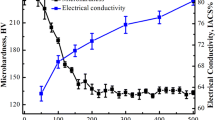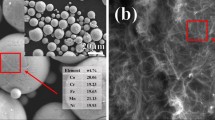Abstract
The isothermal oxidation kinetics of as-cast Cu–17%Cr and Cu–17%Cr–5%Al in air were studied between 773 and 1,173 K under atmospheric pressure. Details of the oxidation kinetics of these alloys were discussed in Part I. This paper analyzes the microstructures of the scale and its composition in an attempt to elucidate the oxidation mechanisms in these alloys. The scales formed on Cu–17%Cr specimens oxidized between 773 and 973 K consisted of external CuO and subsurface Cu2O layers. The total thickness of these scales varied from about 10 μm at 773 K to about 450 μm at 973 K. In contrast, thin scales formed on Cu–17%Cr–5%Al alloys oxidized between 773 and 1,173 K. The exact nature of these scales could not be determined by X-ray diffraction but energy dispersive spectroscopy analyses were used to construct a scale composition map. Phenomenological oxidation mechanisms are proposed for the two alloys.
















Similar content being viewed by others
Notes
All compositions reported in the paper are in wt.% unless otherwise noted.
Specimens were coated with carbon prior to the FESEM, BSE and EDS observations. Thus, carbon peaks were observed in the EDS results.
The X-ray dot maps show that the particle at the bottom of Fig. 11a was deficient in Al, Cr, Cu and Si but rich in O. It is concluded that the particle is a contaminant from the alloy preparation process.
Although the Cr Lα and O Kα peaks overlap, the peak identifications shown in Fig. 12c–f denote only the strongest likely contributor. The source of Si in the spectra is probably due to residual colloidal silica left over from the metallographic preparation process.
References
G. Valensi, in Pittsburgh International Conference on Surface Reactions (Electrochemical Society, Pittsburgh, PA, 1948).
R. F. Tylecote, Journal of Institute of Metals 78, 327 (1950–1951).
D. W. Bridges, J. P. Baur, G. S. Baur, and W. M. Fassell, Journal of the Electrochemical Society 103, 475 (1956).
S. Mrowec and A. Stoklosa, Oxidation of Metals 3, 291 (1971).
F. Gesmundo, C. De Asmundis, and S. Merlo, Werkstofe Und Korrosion—Materials and Corrosion 30, 114 (1979).
K. T. Chiang, K. J. Kallenborn, J. L. Yuen, and N. E. Paton, Materials Science and Engineering A 156, 85 (1992).
J. H. Park and K. Natesan, Oxidation of Metals 39, 411 (1993).
Y. Niu, F. Gesmundo, F. Viani, and D. L. Douglass, Oxidation of Metals 48, 357 (1997).
K. T. Chiang, G. H. Meier, and F. S. Pettit, in Microscopy of Oxidation-3, S. B. Newcombe and J. A. Little (eds.) (The Institute of Materials, London, UK, 1997), p. 453.
Y. Zhu, K. Mimura, J. W. Lim, M. Isshiki, and Q. Jiang, Metallurgical and Materials Transactions A 37A, 1231 (2006).
Y. Niu, S. Y. Wang, and F. Gesmundo, Oxidation of Metals 65, 285 (2006).
S. Y. Wang, F. Gesmundo, W. T. Wu, and Y. Niu, Scripta Materialia 54, 1563 (2006).
G. Plascencia, T. Utigard, and T. Marín, JOM 57, 80 (2005).
G. Ghosh, in Handbook of Ternary Alloy Phase Diagrams, vol. 4, G. Petzow and G. Effenberg (eds.) (VCH Publishers, New York, NY, 1991), p. 311.
B. Grushko, E. Kowalska-Strzeciwilk, B. Przepiorzynski, and M. Surowiec, Journal of Alloys and Compounds 417, 121 (2006).
K. T. Chiang, K. J. Kallenborn, and J. L. Yuen, Surface & Coatings Technology 52, 135 (1992).
A. F. Wright and J. S. Nelso, Journal of Applied Physics 92, 5849 (2002).
Acknowledgements
The author thanks Ms. Joy Buehler for metallographic preparation of the specimens, Mr. Terry McCue for conducting the SEM observations and EDS analyses and the late Mr. Ralph Garlick for conducting X-ray diffraction analyses of the oxidized specimens. The author also thanks the reviewer for his valuable suggestions and comments.
Author information
Authors and Affiliations
Corresponding author
Rights and permissions
About this article
Cite this article
Raj, S.V. Comparison of the Isothermal Oxidation Behavior of As-Cast Cu–17%Cr and Cu–17%Cr–5%Al. Part II: Scale Microstructures. Oxid Met 70, 103–119 (2008). https://doi.org/10.1007/s11085-008-9104-3
Received:
Revised:
Accepted:
Published:
Issue Date:
DOI: https://doi.org/10.1007/s11085-008-9104-3




